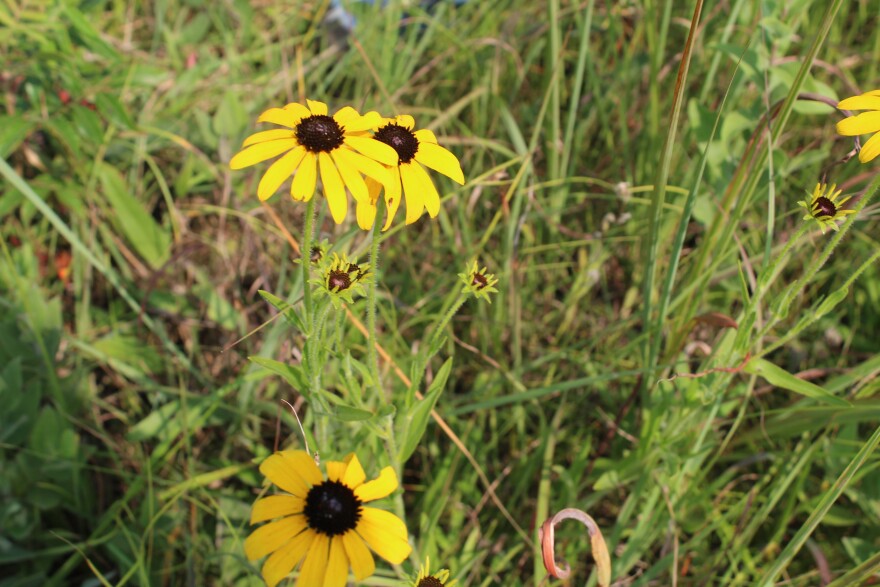
A parcel of land southeast of Bolivar is filled with a variety of grasses and wildflowers. Brown-headed coneflowers and compass plants blow in the breeze. Songs of birds, including the dickcissel, fill the air. There’s a cacophony of insect sounds and the distant hum of traffic from Highway 13.
This is Schuette Prairie, one of three remnant prairies acquired in 2020 by the Missouri Prairie Foundation.
The 40-acre piece of land has never been plowed. Bruce Schuette, vice-president of science and management for the Missouri Prairie Foundation and the person for whom the prairie is named, said it was used for many years as a hay field.
"Usually annually it was mowed and put up for hay," he said, "and so that meant it provided some income for the landowners and yet it still maintained it as a prairie without being plowed."

Once a prairie is plowed, it loses soil structure that’s been in place for thousands of years, and it can never be completely reconstructed.
Shuette Prairie was taken out of its hay regime for awhile and had become overgrown. A man who worked for the Local 101 Hoisting Trust, Rick Means, worked hard for several years to clear the brush and conducted prescribed burns to restore the prairie.
This type of ecosystem was once a significant part of the landscape in southwest Missouri. At one time, according to Schuette, the state had approximately 15 million acres of prairie.
"Now it's estimated that there's probably less than 51,000 acres, you know, with a fairly high quality of the prairie community, and that is continuing to disappear," said Schuette.
Polk County, home to Schuette Prairie, once had 100,000 acres of prairie. Now there are only about 350 acres left, and only 200 acres are in protected ownership. Schuette Prairie was once part of Three Mound Prairie, which was more than 12 miles long and up to two and a half miles wide. Another piece of that prairie, southwest of Bolivar, La Petite Gemme, is under Missouri Prairie Foundation ownership.

Prairies have some of the richest soils on Earth, Schuette said, and the root systems in those soils help sequester carbon dioxide from the air. They’re also important habitat for wildlife.
"It's become an extremely rare habitat type for the native wildlife that depends on this for all the native plants and that that are part of the prairie community and ecosystem," he said. "And we're finding out more and more all the time just how important prairies can be."
Schuette Prairie is no exception. It’s a limestone/dolomite prairie. The bedrock is limestone or dolomite, which gives the soil a different characteristic than other types of prairies.
It’s rich with pollinating insects and native prairie plants. And this prairie is unusual because of its bedrock because it contains plants typically found on glades such as prairie dock, yellow coneflowers and Missouri coneflower, according to the Missouri Prairie Foundation. And the prairie's swale provides habitat for wetter-soil species such as bunchflower, it said.

Schuette pointed out a wildflower that indicates the quality of this prairie. It's a species of ecological conservatism, which means that it's most likely to be found in its native community, in this case a prairie. When that species is found, it indicates a good quality, native commuinty, according to Schuette.
"Here's a rattlesnake master, another one of those," he said. "Here's another plant that is past, but, late spring, this prairie, this burn area was just covered in shooting stars."
There’s also prairie blazing star, lead plant, catclaw sensitive briar and the compass plant, which got its name from its leaves that tend to orient themselves so their flat surfaces face east and west.
Visit the prairie at various times during the growing season, and it will look different each time. On this day there were dried heads of coneflowers that had already bloomed.
"In places you can see they were just covering this prairie, probably a month or a month and a half ago," Schuette said.
So far, the Missouri Prairie Foundation has identified 130 plants at Schuette Prairie, according to Schuette, and he expects that number to increase significantly. Thirty-seven of those plants are prairie dependent.

An extremely rare moth called the rattlesnake master stem borer has been found here. And a moth recently discovered in Missouri lives there, too. The tiny moth is only a couple of millimeters long.
"It's just so obscure," Schuette said, "but it lays its eggs in these heads of rattlesnake, and the larva feed in it."
A college student is doing research at Schuette Prairie on a group of beetles that's dependent on prairie habitat.
The Missouri Prairie Foundation encourages people to visit their prairies to walk, take photographs and do nature study.
Schuette hopes people will come to appreciate prairies, which were once a big part of the landscape in the Ozarks.
"These plants, in many cases, were used by native Americans as well as then the early European American settlers moving in used many of these plants for food, some they used for medicine," he said. "They're really a part of our history and still so important to us now."
The Missouri Prairie Foundation owns 29 tracts of land in Missouri, totaling 4100 acres. About half of that land is unplowed prairie, and most of the land is in southwest and western Missouri, from Joplin to Springfield and up to Kansas City and Sedalia.
The organization is funded by memberships, donations and grants.
Find out more at moprairie.org.
Directions to Schuette Prairie: From Highway 13 south of Bolivar, turn east on E. 490th Rd., go about two miles and turn south on 160th Rd. The prairie will be on the east side of the road about 3/4 of a mile down 160th. There is currently no designated parking area, so you'll have to park along the road.





